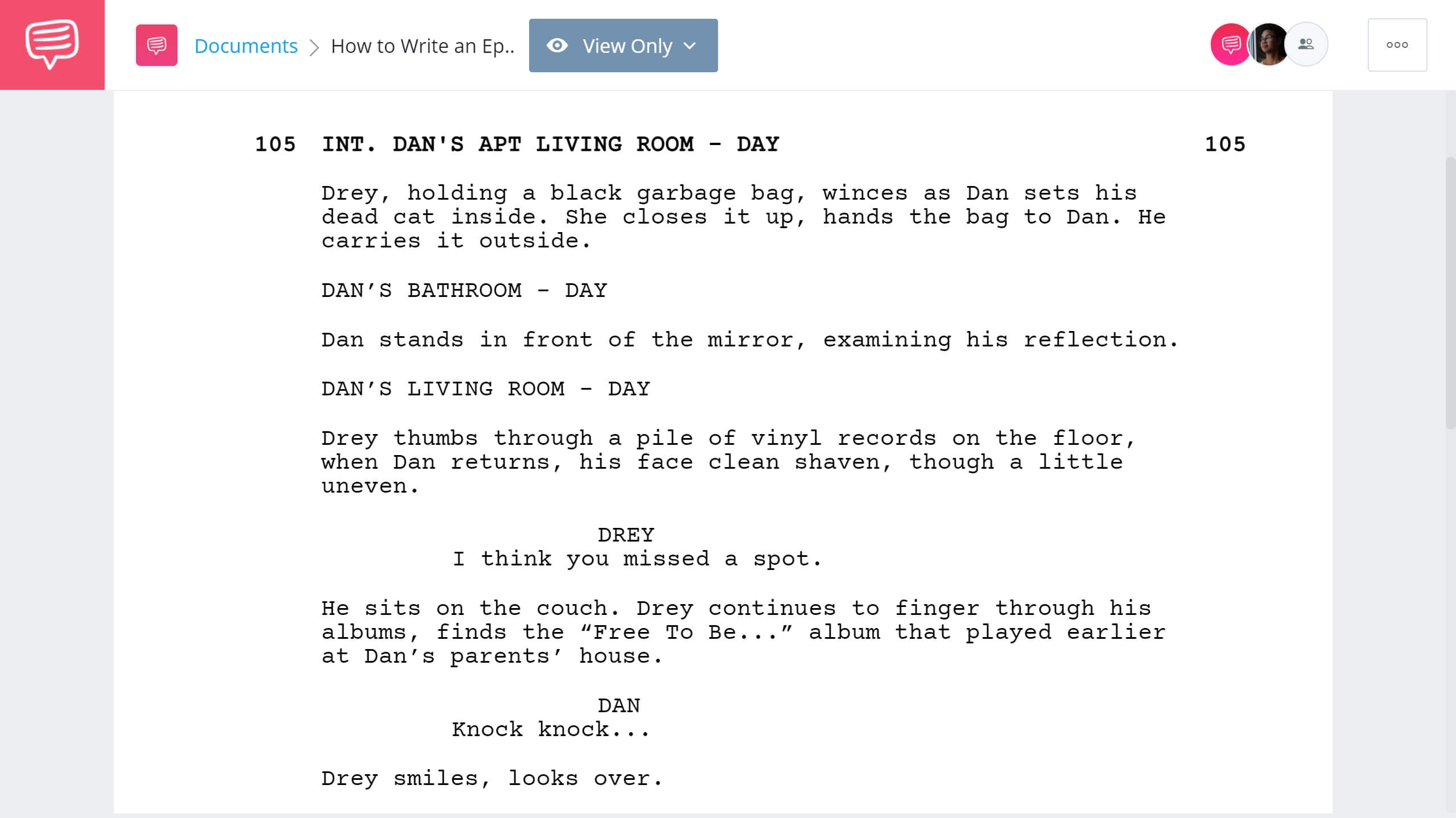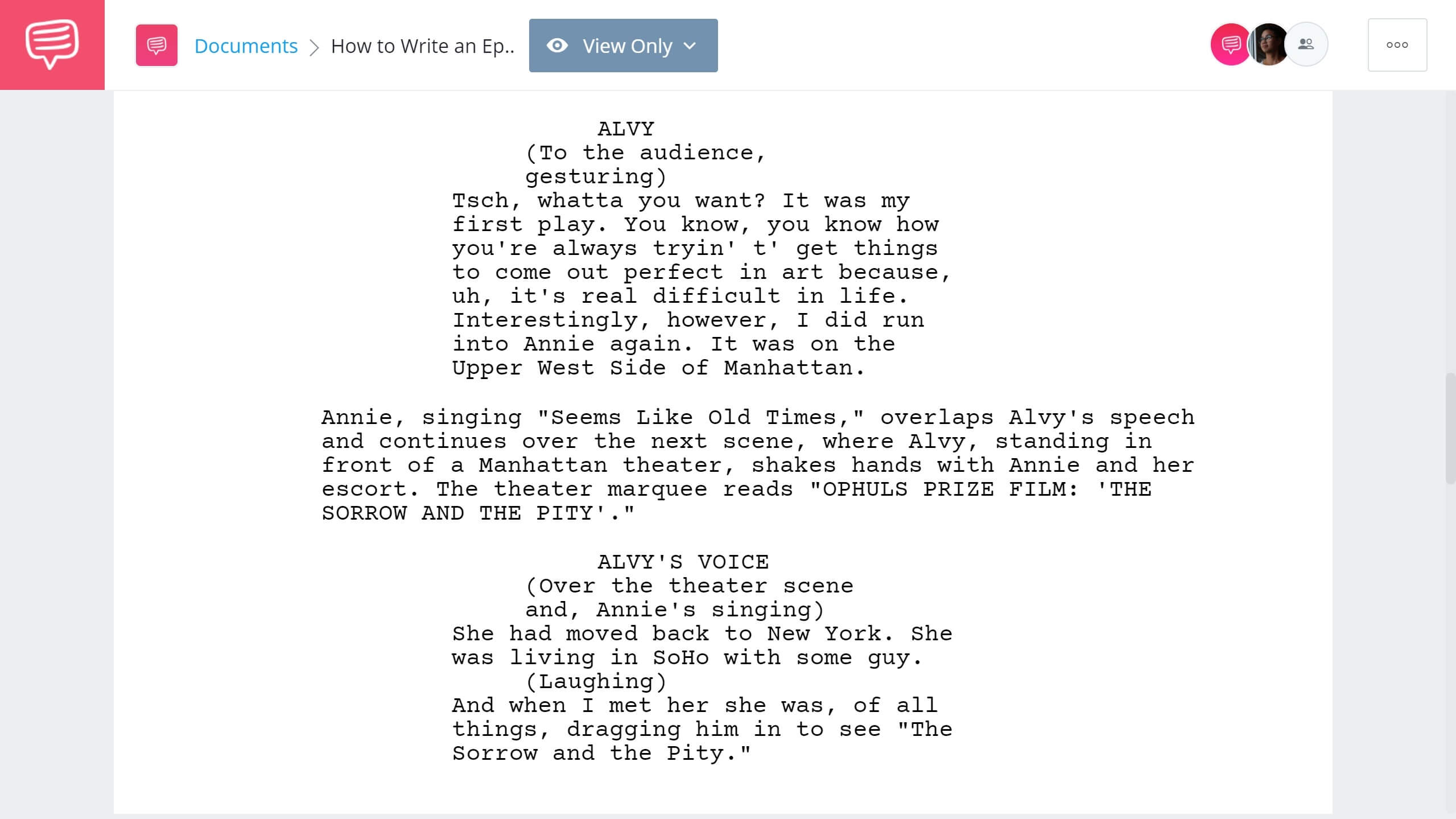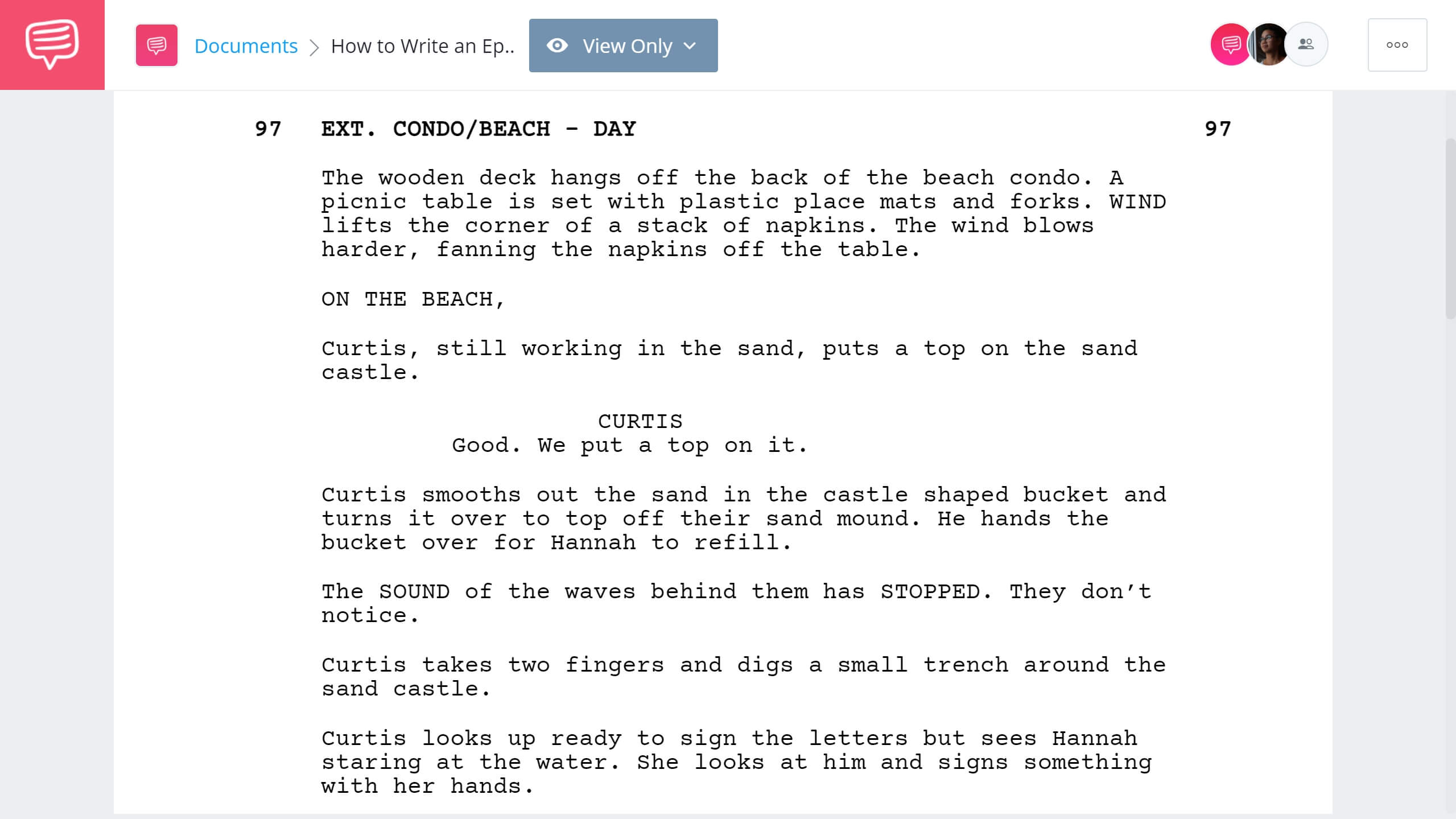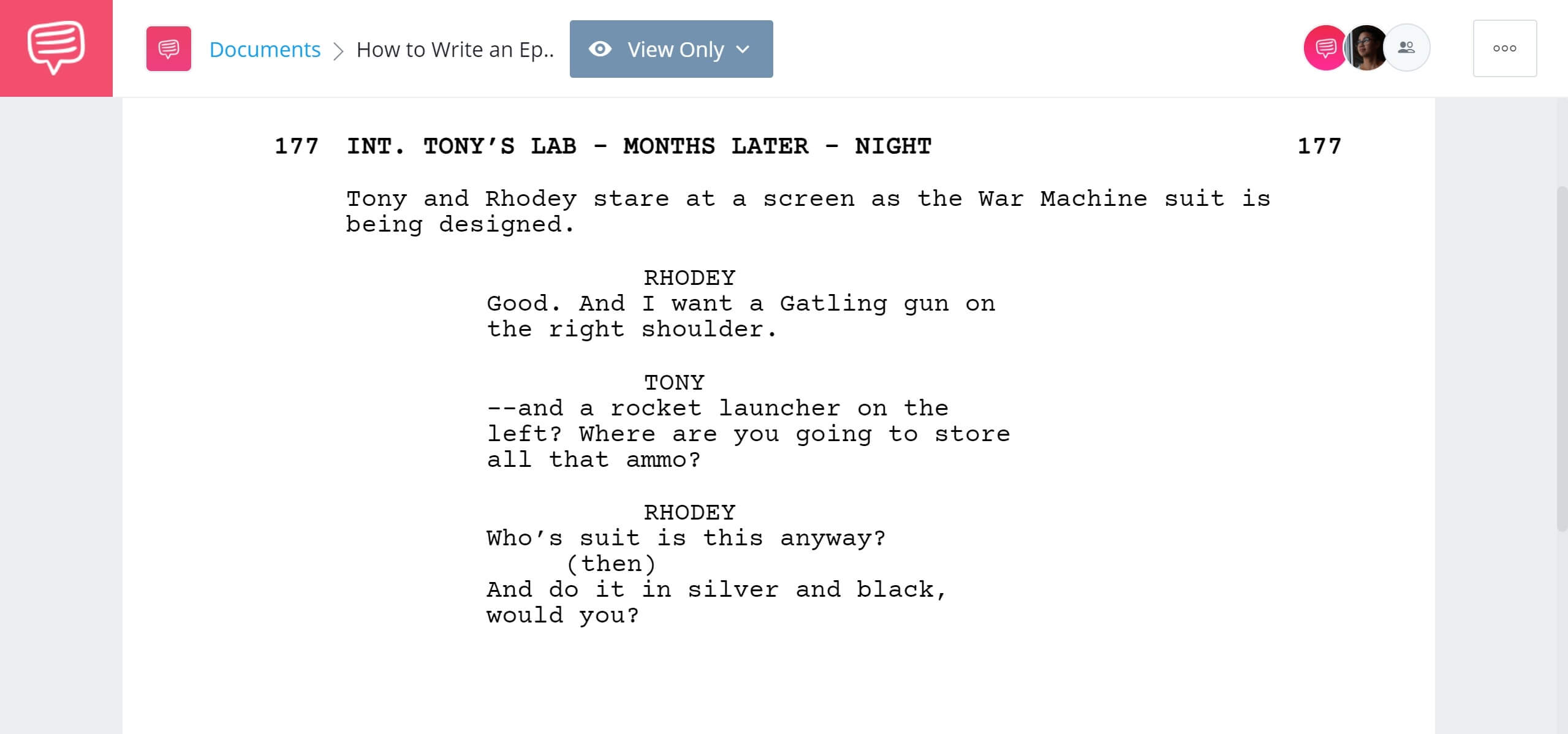So you’ve finished your story: the primary antagonist has been defeated; the main-plot has been resolved — but something still feels incomplete. Don’t worry, many writers struggle to find that ever-so-coveted perfect ending. One way to add further resolution to a story’s conclusion is by adding an epilogue. We’re going to show you how to write an epilogue that’s resolute and satisfying, with screenplay examples from Half Nelson, Annie Hall, and more. By the end, you’ll know how to write an epilogue that aids your story not ails it.
How Do You Write an Epilogue
The importance of a story’s ending
There’s no other way to say it: the ending is one of the most important parts of a story. Why? Because it’s the last thing we see before we close a book or before the credits roll. As such, we have to be mindful of all the things that make an ending good or bad.
This next video does a great job of explaining how writer/director Damien Chazelle crafted two near-perfect endings with Whiplash and La La Land.
How to Write an Epilogue • How Damien Chazelle Crafts an Ending
Another reason why this video is so good as it relates to “how to write an epilogue,” is because one example uses an epilogue, but the other doesn’t. Remember: epilogues are not essential aspects of storytelling.
Many writers confuse epilogues with denouement. But whereas the former is non-essential and supplementary, the latter is essential and responsible for thematic resolution. I suppose it’s all semantics in one way or another – the most important thing to remember is that epilogues and denouement are intended to create satisfying endings.
Oftentimes, the best endings are communicated without any exposition, in a simple and reflective way.
We imported a series of stills from some of the most famous epilogues of all-time into StudioBinder’s Shot Listing software.
Click the link below to see the iconic epilogue examples.
Where is the epilogue in a book in comparison to afterwords?
Epilogue vs. afterword
Epilogues are often confused with afterwords. Both pieces of writing appear at the end of a narrative, but they differ in perspective.
An epilogue occurs within the story world, typically as a followup to the narrative that has just concluded.
An afterword, meanwhile, is written from the point of view of the author, editor, or other contributor. It offers a perspective on the text from outside of its world.
In this way, an afterword functions a lot like a forward. Afterwords are most often found in nonfiction or older, more famous fiction. Usually, they are added to contextualize the story just told. In nonfiction, this might be an update on the focus of the piece. In fiction, it may be the author detailing how they came up with the now-famous book.
How to Write an Epilogue for a Book or a Screenplay
Align your epilogue with the plot
When we first learn about epilogues, we’re often in a literary setting, which incites someone to ask “where is the epilogue in a book?” Of course, that’s an easy question to answer.
The epilogue always takes place at the end of the story.
One of the biggest reasons why epilogues are considered taboo in writing is because they’re often used as an addendum to the events of a story, not as part of the story itself. When writers do this, it usually results in us tapping our toes in anticipation of the story’s end.
So how do we avoid this? Well, we have to go back to the beginning, and re-examine the plot structure in a new light.
I know, I know, you’re probably thinking “I just finished my story! Now I have to go back and start from the beginning?” The simple answer to that question is yes — the longer answer is not really.
Writers don’t always plan on using epilogues, but that doesn’t mean there aren’t ways to make it seem like they were always planned. Check out our video below on Dan Harmon’s story circle as we break down eight proven steps to writing a better story structure.
The last step of Harmon’s story circle is dedicated to “change.” Think about the most satisfying stories of all-time and how their characters clearly change from beginning to end.
How to Write an Epilogue for a Book or a Screenplay • Subscribe on YouTube
Oftentimes the best epilogues show us “what becomes” of a story’s characters. As such, epilogues create ample opportunity to show how characters change over time.
One of the major themes of the 2006 film Half Nelson is how history equals change over time. We imported the Half Nelson script into StudioBinder’s screenwriting software to look at how writers Anna Boden and Ryan Fleck used thematic overtones and plot structure to give resolution to their characters.
In this scene, we quite literally see the story’s protagonist Dan “clean himself up” by shaving.
Epilogue Examples • Read the Half Nelson Screenplay Epilogue
The ending isn’t anything groundbreaking, but it is a great example of how to write an epilogue. As you consider writing your own epilogue, think back to Half Nelson and Dan Harmon’s story circle for reference.
How to Write an Epilogue With a Flashback or Flash Forward
Consider flashing forward
A lot of the best epilogues of all-time take place long after the main events of the story. Why? Because time heals all wounds. Oh, and distance helps characters see things in a new light.
We’ve seen this strategy used to expert effect in films like Harry Potter and the Deathly Hallows, but perhaps the best example of this type of epilogue is in Woody Allen’s Annie Hall. Pay attention to how Allen frames this scene.
Epilogue Examples • Read the Annie Hall Screenplay Epilogue
The ending of the Annie Hall screenplay is one reason why it’s considered among the greatest screenplays of all-time. But why is it so good? Well, I’d say there are three reasons:
- It’s short and sweet
- It’s layered with a metaphor
- It uses the past and the present as a means of juxtaposition
As a writer, I’m inclined to give more merit to the second and third of those three points, but it’s really the first that matters the most. I think most people would agree that it’s not possible to write a great epilogue if it’s long, and by long I mean over 5-7 pages of a screenplay.
Perhaps it might be helpful to think of it this way: if your story is an ice cream sundae, an epilogue could be the cherry-on-top. It doesn’t make the sundae better per se, but it’s something small that makes it sweeter.
How to Write an Epilogue That Seems Fresh
Don’t be afraid to buck the trend
Perhaps the most tired trope in storytelling is when everybody lives “happily ever after.” Funny enough, the antithesis of this trope — everybody dies — has become a trope too! So how do writers buck the trend and create endings that are refreshing and new?
Well, it’s not easy. We’ve seen a lot of stories over the past 5,000+ years, and most of them share a similar structure. But that doesn’t mean there isn’t room to riff on conventions in storytelling.
Take Jeff Nichols’ Take Shelter for example: the whole story is set-up around a man who believes the world is going to end. Sound familiar? We’ve seen this trope a thousand times, but Nichols frames it in a way that has us guessing until the very end. Was Curtis right the whole time or was he insane?
Let’s look to the script for answers (SPOILER ALERT!).
Epilogue Examples • Read the Take Shelter Screenplay Epilogue
Up to this point, the story up to this point has been framed through Curtis’s point of view — he sees apocalyptic visions, so we see them too. But in this final epilogue scene, his wife and daughter see the storm. This confirms our suspicion that Curtis isn’t insane. Now, it could be argued that this epilogue doesn’t take place in reality, but either way, it’s a tense finale to a psychologically thrilling story.
Epilogue Examples That Set Up a Sequel
Set-up a sequel
Epilogues are commonly used in big-budget Hollywood movies to set-up sequels. Although there’s some conjecture as to whether or not “post-credits” scenes are epilogues or not, I think it’s fair to say that they offer a lot of the same utility.
Let’s look at the post-credits scene for Iron Man to see what makes it different from a traditional epilogue, while still offering many of the same benefits.
Epilogue Examples • Iron Man Post Credits Scene
Iron Man was the first movie in the Marvel Cinematic Universe, and it established a precedent for superhero post-credits scenes. In many ways, this scene plays out like a traditional epilogue – we’re shown future events that resolve the arc of the story – but in another sense, it also serves to set-up the next entry in the series.
This epilogue scene wasn’t in the Iron Man screenplay though. Instead, there was a different scene where Tony and Rhodey work on the War Machine suit. You can read that scene below:
Epilogue Examples • Read the Iron Man Screenplay Epilogue
It’s highly probable that an epilogue was always planned for Iron Man, but early drafts didn’t include references to The Avengers. When The Avengers was officially greenlit, the Marvel team likely reworked the script to connect the two films. So, when writing a spec script or a franchise script, consider leaving things open for production to make changes. Just remember that there should always be a placeholder keeping the structure together until things change.
How to write an epilogue
How to write an epilogue in 5 steps
Now, let’s go through some steps you should think about when writing your next epilogue. Remember, every epilogue is different, but these considerations can be pretty generally applied.
1. Consider why you need an epilogue
What purpose is your epilogue serving? Why is this an epilogue and not just another chapter? Asking yourself these questions will help you sharpen the focus of your epilogue.
If you don’t have good answers, then that may tell you something. You can probably skip this type of conclusion.
2. Decide on the information to include
This goes hand-in-hand with the first step. You’ve decided you need an epilogue, so now you need to think about what information needs to be included. What does the reader need to know that they haven’t already gleaned from the final chapter?
3. Stay brief
An epilogue occurs after a story is concluded, so don’t overstay your welcome. Leave the reader wanting more. Since your epilogue is a jump forward in time, you may have to introduce some new characters, but try to limit any introduction of new storylines or locations. Again, this is a cherry on top, not a whole new narrative.
4. Maintain style
Usually, you don’t want your epilogue to be a huge departure in style. Sure, it may be a new perspective, a new location, or new characters, but you don’t want to completely divorce your epilogue from the tone of the rest of the narrative. This runs the risk of being jarring and confusing (though if that’s what you’re going for, great).
5. Deliver or rescind closure
Often, the function of an epilogue is to give readers any closure the end of the narrative may not have provided. You can show the audience where characters ended up, and how things worked out (or didn’t work out).
Alternatively, if your narrative provides closure but you want to build interest for a sequel, an epilogue can do the opposite. An epilogue allows you to create a cliffhanger while also providing closure in the final pages of the actual narrative. It’s having your cake and eating it too.




